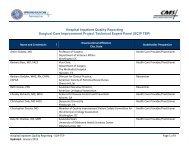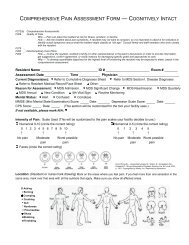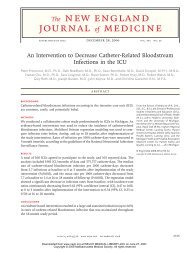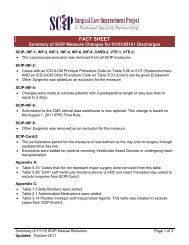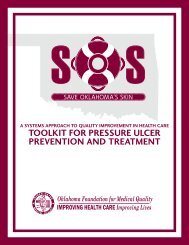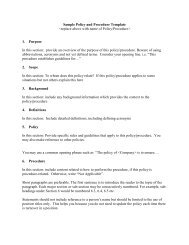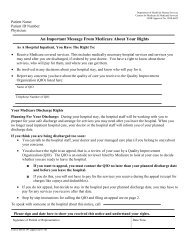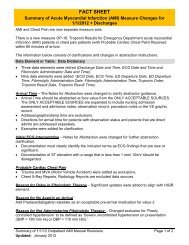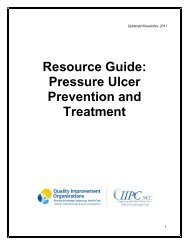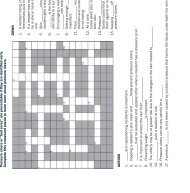Pressure Ulcer Brochure - Oklahoma Foundation for Medical Quality
Pressure Ulcer Brochure - Oklahoma Foundation for Medical Quality
Pressure Ulcer Brochure - Oklahoma Foundation for Medical Quality
Create successful ePaper yourself
Turn your PDF publications into a flip-book with our unique Google optimized e-Paper software.
“Doctor, Please Talk To Me.”<br />
Communicate with patients, family members and nursing staff about appropriate prevention and treatment techniques. Use the expertise<br />
of specialists/nurses certified in wound care and consider a referral to a wound center.<br />
When The Threat Of Litigation Arises:<br />
Take steps to reestablish trust with the family, reassess the patient, reevaluate the care plan, document problem behaviors, and incorporate<br />
<strong>Quality</strong> Improvement principles 7 . If you use and document accepted standards of care <strong>for</strong> prevention and treatment and communicate<br />
with the patient and family, you are less likely to be at risk <strong>for</strong> litigation.<br />
“Doctor, Please Notice Me”<br />
1<br />
Russo, CA, Steiner C, Spector W. Hospitalizations related to pressure ulcers 2006. HCUP Statistical Brief #64, December 2008. Agency <strong>for</strong> Healthcare<br />
Research <strong>Quality</strong><br />
2<br />
Armstrong DG, Ayello EA, Capitulo KL, et al. New opportunities to improve pressure ulcer prevention and treatment: implications of the CMS inpatient<br />
hospital care present on admission (POA) indicators/hospital-acquired conditions (HAC) Policy. J Wound Ostomy Continence Nursing. 2008;35(5):485-<br />
492.<br />
3<br />
Centers <strong>for</strong> Medicare & Medicaid Services, Medicare Program; Proposed Changes to the Hospital Inpatient Prospective Payment System and Fiscal Year<br />
2009 Rates; Proposed Changes to Disclosure of Physician Ownership in Hospitals and Physician Self- Referral Rules; Proposed Collection of In<strong>for</strong>mation<br />
Regarding Financial Relationships Between Hospitals and Physicians; Proposed Rule Federal Register. 2008;73(84):23550.<br />
4<br />
Hanging Wet-to-Dry Dressings Out to Dry, Liza G. Ovington, PhD, CWS; Home Healthcare Nurse, p 477, vol 19 no 8 August 2001; ©2001 Lippincott<br />
Williams & Wilkins, Inc<br />
5<br />
Bryant, 2007<br />
6<br />
AHCPR, 1994; WOCN Society 2001<br />
7<br />
Risk management <strong>for</strong> pressure ulcers: when the family shows up with a camera. Levine JM, Savino F, Peterson M Wolf CR; Journal of the American<br />
<strong>Medical</strong> Directors Association. 9(5):360-3, 2008 Jun.<br />
Your Patient’s Largest Organ Needs Your Attention.<br />
Insights For Reducing Costs, Pain And Suffering And Physician Risk.<br />
This material was prepared by <strong>Oklahoma</strong> <strong>Foundation</strong> <strong>for</strong> <strong>Medical</strong> <strong>Quality</strong>, the Medicare <strong>Quality</strong> Improvement Organization <strong>for</strong> <strong>Oklahoma</strong>, under contract with the Centers<br />
<strong>for</strong> Medicare & Medicaid Services (CMS), an agency of the U.S. Department of Health and Human Services. The contents presented do not necessarily reflect CMS policy.<br />
962PU-1034-OK-510
Physicians, Reduce Your Risk And Improve Care<br />
2.5 million patients are treated <strong>for</strong> pressure ulcers every<br />
With these <strong>for</strong>midable costs, pain and suffering, and potential<br />
year 1 . The national cost of care exceeds $11 billion each<br />
<strong>for</strong> litigation, it’s time to give the skin the attention it<br />
year 2 , with an average DRG payment of $43,180 per patient deserves, and reduce your risk. This guide presents the latest<br />
<strong>for</strong> treatment. 3 Serious pressure ulcers are considered a “never science and recommendations <strong>for</strong> incorporating principles of<br />
event” among hospital-acquired conditions with payment<br />
pressure ulcer prevention into everyday practice and<br />
implications.<br />
using appropriate treatment methodology. For more detailed<br />
in<strong>for</strong>mation, visit http://www.ofmq.com/sos-tools.<br />
“Doctor, Please Look At Me”<br />
Skin assessment <strong>for</strong> high-risk individuals should be part of<br />
your routine practice. It doesn’t take an expensive CAT Scan,<br />
MRI, endoscopy or even a lab test! Almost 90% of pressure<br />
ulcers occur in the posterior pelvic region and the heel/ankle<br />
region. It is particularly essential to assess these pressure points<br />
on elderly and immobile patients. It takes 2-3 minutes to assess<br />
as preventable and primarily reversible affliction.<br />
<strong>Pressure</strong> ulcers that<br />
reach full thickness<br />
damage (stages 3&4) will<br />
never heal beyond 80%<br />
tensile strength. Assess<br />
the skin early and often<br />
to prevent worsening of<br />
pressure ulcers.<br />
The Best Treatment Is Prevention<br />
Who Is At Risk<br />
High Risk Factors <strong>for</strong> <strong>Pressure</strong> <strong>Ulcer</strong> Patients<br />
• Elderly<br />
• Immobile<br />
• Neurologically Impaired<br />
• Prolonged OR Time<br />
• Time in ER<br />
• Complicated Hospital Course<br />
• Co-morbidities (diabetes, vascular diseases, renal compromise)<br />
• Chronically Ill<br />
• Obese/Malnourished<br />
• Post-Surgical<br />
• Incontinent<br />
• Chronic Pain<br />
Where To Look<br />
Key Areas Susceptible To <strong>Pressure</strong> <strong>Ulcer</strong>s<br />
• Bony Prominences<br />
• Posterior Pelvic Region<br />
• Heels and Ankles<br />
What To Look For<br />
Conditions That Will Alter Your Plan Of Care<br />
• Be familiar with latest staging guidelines<br />
(http://www.npuap.com)<br />
• Notice reddened areas.<br />
• Learn to differentiate pressure ulcers from other types of<br />
wounds.<br />
• Wounds such as diabetic and neuropathic ulcers and<br />
venous arterial insufficiency ulcers are often incorrectly<br />
classified as pressure ulcers. Misidentifying wound etiology<br />
can lead to an incorrect treatment plan.<br />
• For example: Treating an exudating venous ulcer as a<br />
pressure ulcer will be fruitless. Applying full compression<br />
on a leg without establishing arterial status, such as<br />
with an ankle-brachial index (ABI) or toe-brachial index<br />
(TBI) is negligent.<br />
Opportunities For Assessment<br />
• On admission into acute care - Pre<strong>for</strong>m a head to toe,<br />
front to back assessment. Physician should document<br />
breakdown on admission (consistent with nurse documentation).<br />
• In office - Check sacral area when doing exams such as<br />
rectal and hemocult testing. Assess pressure points on<br />
elderly and immobile patients.<br />
• Be<strong>for</strong>e dictating discharge summary from acute care<br />
- Check <strong>for</strong> skin breakdown. Make arrangements <strong>for</strong><br />
wound care if needed.<br />
• Post surgery - as patient is moved to gurney<br />
“Doctor, Dress Me Up And Treat Me Right”<br />
Gauze For Alarm<br />
Bacteria can pass through 64 layers of gauze. The infection rate with gauze dressings is nearly 3x higher than with moisture retentive<br />
dressings 4 . Wound care experts agree that the use of wet-to-dry mechanical debridement should be restricted to heavily necrotic<br />
wounds and discounted when viable tissue is present 5 .<br />
Modify Don’t Toxify<br />
Do thy patient’s proliferating cells no harm. “Let’s dry them bugs up with betadine and kill ‘em,” is old thinking, not quality wound<br />
care. Historically, antiseptics were used <strong>for</strong> decontaminating infected wounds. Today, (routine use of alcohol, betadine, hydrogen<br />
peroxide, saline solution or acetic acid) is generally discouraged because their cellular toxicity exceed their bactericidal (bacteria killing)<br />
activity 6 .<br />
Time For A Change<br />
No, not likely. Advances in dressings allow us to minimize the frequency of dressing changes. Every time a pressure ulcer dressing is<br />
changed, it takes 4 to 6 hours to regain the ideal healing temperature. Don’t order twice a day or even daily dressing changes unless<br />
they are really needed. However, if a wound has failed to progress over a 2-4 week period, reassess the wound and consider a different<br />
treatment plan. For example, a topical antibiotic or treatment of the epibole may need to be considered.




